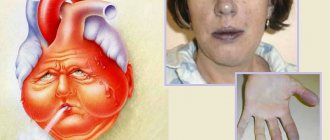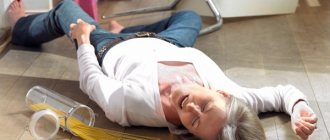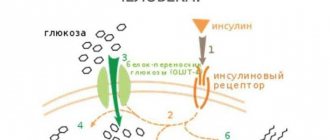Capillary bleeding is one of the most common types of bleeding. As the name implies, blood flows out of small vessels - capillaries. Such bleeding can be external and internal - when blood flows into the cavity of the internal organs (uterus, stomach, intestines, lungs, bladder).
If the capillary bleeding is internal, then with extensive blood loss the patient may develop signs of anemia: pale skin and mucous membranes, a drop in blood pressure, increased heart rate and breathing, and fainting.
Signs of capillary bleeding and differences from venous
Capillary bleeding, which can be stopped with the help of improvised means, has characteristic symptoms. When small vessels rupture, liquid connective tissue spills into the cavity of the internal organs or into the external environment.
Main features:
- the blood flowing from the capillaries is bright red;
- there is no pulsation;
- biological fluid is released evenly and in small quantities;
- the wound is bleeding over the entire area.
In most cases, in people who do not have vascular diseases, the hemorrhage stops on its own, even if a large area is injured. With internal bleeding, connective fluid is present in tracheobronchial secretions, vomit or feces, as well as in urine.
Often internal hemorrhages are asymptomatic.
The latent form is recognized by a number of characteristic features:
- blood pressure surges;
- superficial weak pulse;
- increased heart rate;
- feeling of dry mouth;
- partial short-term loss of vision;
- dizziness;
- general weakness, fatigue;
- cyanosis or pallor of the skin.
The patient may experience aching pain at the site of the rupture. It is almost impossible to detect internal bleeding on your own. The patient should go to the nearest medical facility, where a specialist will examine him and prescribe a comprehensive examination.
Capillary bleeding is difficult to confuse with venous bleeding. When a large vessel ruptures, connective fluid flows out of the wound in a stream and has a dark burgundy color. The bleeding is continuous and profuse, there is no pulsation.
Signs and types of bleeding
Signs of capillary bleeding:
- The blood that comes out from the wound is bright red,
- Blood leaves the affected vein without pulsation,
- Fluid flows from the entire area of the injured area.
If the injured person does not have blood pathologies, then capillary bleeding outside the body stops on its own. But in case of injury, internal organs may be damaged and bleeding may occur in these organs.
In this case, this internal hemorrhage can only be stopped by providing first aid. If there are visible symptoms of bleeding of internal organs, it is necessary to call an ambulance.
Types of bleeding.
| Type of bleeding | Signs of each type of bleeding |
| Capillary | Blood does not flow out quickly from the affected area, without pulsation, and has a bright red hue. |
| Arterial | The blood that flows from the affected area and has a bright scarlet hue flows out in a strong stream or gushes out in a fountain with strong pulsation if a large-diameter artery is affected. |
| Venous | The blood is quite dark, with continuous bleeding with a large volume of fluid coming out. Blood comes out of the vein in a stream, without pulsating impulses. |
What characterizes the health- and life-threatening condition of arterial venous bleeding.
Symptoms of severe blood loss:
- Weakness of the body
- Pale skin
- Dry mucous membranes,
- Drowsiness,
- Low blood pressure,
- Increased heart rate
- Dizziness and fainting,
- Drops of sweat on the face
- Rapid and intermittent breathing,
- Nausea and loss of consciousness.
Types of capillary bleeding
Capillary bleeding (it can be stopped in several ways) is classified according to the location of the vessel rupture (external and internal) and the reason for its appearance:
| Impact factors | Description |
| Injuries | Thermal and chemical burns. They occur due to skin contact with hot liquids, acids and other substances. Provoke external bleeding. |
| Abrasions, cuts. Appear as a result of a blow or fall. Cause external hemorrhages. | |
| Coagulopathic changes | Von Willebrand's disease. A hereditary pathology is accompanied by spontaneous rupture of small blood vessels. There is a deficiency of plasma von Willebrand factor. |
| Hemophilia. The disease is inherited. The pathology is characterized by a violation of the blood clotting process. When blood vessels rupture, biological fluid penetrates into the cavity of internal organs, joints and muscles. | |
| Hemorrhagic diathesis (thrombocytopenic purpura). Internal hemorrhages occur against the background of a sharp decrease in the number of platelets. | |
| Pathological changes | Hormonal disorders. A deficiency of organic compounds produced by the endocrine glands leads to thinning of blood vessels. |
| Necrosis. When cells die, the blood circulation in the affected area is disrupted. The walls of blood vessels become fragile. | |
| Atherosclerosis. The pathology is characterized by the growth of fatty plaques inside blood vessels. There is a narrowing and deformation of the lumen of the capillaries. | |
| Inflammatory processes. Capillaries penetrate soft tissues. During inflammation, blood vessels are affected, which leads to their rupture. | |
| Benign and malignant tumors. The growth of cancer cells leads to deterioration of blood clotting. |
Internal hemorrhages most often occur due to pathological and coagulopathic changes occurring in the body. Capillary rupture also occurs due to a fall from a great height.
Causes
Most often, the pathology develops due to injuries due to blows, bruises, and fractures. Purulent and necrotic processes also lead to damage to the capillaries, as a result of which external or internal bleeding may develop. Pathology can occur with burns or frostbite.
Changes in blood composition can also cause capillary bleeding. An unpleasant phenomenon can be observed in the following diseases:
- scurvy;
- jaundice;
- hemophilia;
- scarlet fever, etc.
Frequent nosebleeds are a sign of weak capillaries
Chronic diseases can lead to the development of complications in the form of hemorrhages. Atrophic processes, ulcers, dangerous neoplasms - the result of all this is often blood loss. Internal gastric bleeding often develops with gastritis. Hormonal imbalances or improperly performed abortion can cause uterine bleeding. Tuberculosis, pneumonia - these diseases often lead to internal bleeding of the lungs. If the problem is not related to injury, the doctor will be able to determine the exact cause of the pathological process after laboratory and instrumental examinations of the patient.
Frequent bleeding is observed in patients with weak vessel walls. The risk group includes:
- patients over 60 years of age;
- people leading a sedentary lifestyle;
- patients with a deficiency of vitamins C, P, E;
- patients with vascular atherosclerosis.
Strengthening the walls of blood vessels may be necessary after prolonged flu or other infectious diseases. Frequent nosebleeds are a sign that you should consult a hematologist (a specialist who deals with blood diseases).
Why is capillary bleeding dangerous?
Capillary bleeding can be stopped with a cold compress. Many people mistakenly believe that rupture of a small vessel is not dangerous. External capillary bleeding, especially if a large area of the skin has been damaged, can trigger the development of blood poisoning.
Sepsis can be:
- chronic;
- sharp;
- lightning fast.
The latter type is characterized by a rapid course of the disease. Blood poisoning occurs within a few hours. Symptoms of the pathological process cannot always be identified in a timely manner. An increase in temperature after injury indicates the development of an inflammatory process. The patient should consult a doctor.
Indirect symptoms of sepsis include:
- rave;
- unstable psycho-emotional state;
- formation of ulcers on the skin;
- disturbances of the gastrointestinal tract (vomiting, diarrhea);
- chills;
- fever;
- weakness accompanied by increased sweating;
- superficial pulse;
- increased heart rate.
Local signs of blood poisoning after abrasions and cuts include:
- increase in temperature at the site of damage;
- painful sensations when touching the wound.
If the infection has penetrated the lymphatic ducts, then characteristic red stripes appear on the surface of the skin.
Internal bleeding is considered the most dangerous to human life. The rupture of blood vessels is accompanied by an outpouring of liquid connective tissue into the cavities of the internal organs. In this case, there is a high risk of blockage of blood vessels: blood accumulating inside the body promotes the active development of bacteria, which accelerates the development of the inflammatory process.
Providing first aid before the doctor arrives
Capillary bleeding, which can be stopped in several ways, indicates damage to one or more vessels. For external hemorrhages, a hemostatic sponge is used.
A pharmaceutical product with broad-spectrum collagen is used in emergency cases with severe bleeding. The hemostatic sponge helps speed up the process of regeneration of damaged tissues, and an antiseptic effect is observed.
The composition is completely natural, it includes:
- collagen solution obtained from the skin and tendons of cattle;
- furatsilin;
- nitrofuran;
- boric acid.
The pharmaceutical product is heat-resistant; it can withstand temperatures up to 75° C. The hemostatic sponge has no structural analogues. The product prevents large-scale blood loss, more quickly restores the integrity of the skin and damaged blood vessels.
Therapeutic actions:
- sorbent;
- tonic;
- regenerating;
- antimicrobial;
- antiseptic;
- bactericidal.
It looks like a yellow pressed powder. In the pharmacy, the sponge is sold without a prescription, the dimensions are 5x5 cm or 9x9 cm. Pharmaceutical products stop not only capillary, but also alveolar and parenchymal bleeding. It can be used to stop unsanitary conditions.
The collagen sponge has virtually no contraindications, with the exception of hypersensitivity to the components present in the composition. For arterial bleeding, the drug is not used.
Pressure bandage
A pressure bandage helps stop venous and capillary bleeding. In arterial cases, this method is rarely used. After a mastectomy or phlebectomy, a fixing bandage acts as a preventive method for possible hemorrhages. The main indications for use are swelling.
Required materials and tools:
- gauze bandage;
- compression pillow;
- napkin or sterile swab;
- antiseptic solution.
The pressure pad, as the main element, must be large enough, dense and flexible. The latter factor ensures a tighter fit to the wound; the blood stops due to uniform pressure, leading to compression of the blood vessels. The pressure pad is included in the dressing kit, which can be purchased at the pharmacy.
In emergency situations, the pressure pad is replaced with cotton wool or a sterile bandage folded in several layers. The dressing technique may vary depending on the type of dressing material and the location of the wound.
Using a dressing package (standard action algorithm):
- wash your hands with soap or wipe with alcohol;
- treat the damaged surface with hydrogen peroxide, furatsilin solution or potassium permanganate;
- open the dressing package;
- Apply a sterile napkin to the wound and secure with a bandage;
- Apply a pressure pad and secure it with a bandage.
In case of severe capillary bleeding, the pillow quickly becomes saturated with blood, so it is necessary to apply gauze or a sterile bandage on top. An open wound should not be washed with antiseptics. Disinfect the area near the cut, scrape or burn. The skin is wiped from the edge to the periphery of the wound, removing small debris.
Cold compress
Ice, which is applied to the affected area of the skin for cuts and abrasions, can quickly stop capillary bleeding. A gauze pad soaked in cold water is applied to the wound. Using a cold compress can reduce the amount of liquid connective tissue released during internal bleeding.
To do this, an ice pack, wrapped in a towel several times, is applied to the site of possible localization of the injury (sternum, abdominal cavity). In case of internal bleeding, the victim should be placed on his back and his head should be turned to the left or right side. A cold compress can also help stop nosebleeds.
Application of a compressive tourniquet. Rules and algorithm
A tourniquet is a specialized first aid device used to stop capillary bleeding. Of all the existing types, “Alpha” is considered the most effective and safe. The product does not provoke necrosis and does not injure nerves and arteries. The design has a ribbed surface that allows you to maintain normal blood flow in the affected area.
For light bleeding, do not use a tourniquet; it is replaced with a fixing bandage. Complications that developed due to improper application of a specialized product. These include amputation of a limb, partial or complete loss of sensation in the injured area.
Overlay algorithm:
- Patients are positioned so that the injured area is above chest level. If a limb (arm or leg) is injured, it is slightly raised. When the wound is located on the body (peritoneal area), the victim is turned over on his side.
- The material used as a tourniquet must be soft. They are used to tighten the wound just above the injured area over clothing. Before applying a tourniquet, the abrasion or cut is treated and fixed with a bandage.
- Monitoring of the correct application of the tourniquet, which leads to a complete stop of bleeding, is carried out regularly. It is necessary to observe the pulsation below the wound fixation site.
The main errors in applying a tourniquet include:
- lack of time control;
- lack of lining for the tourniquet;
- too weak or strong compression of the damaged area.
Remove the tourniquet carefully and slowly. It is unwound carefully, trying not to damage the vessels. No more than 120 minutes should pass from the moment of application. In most cases, bleeding stops during this period.
Rules for applying a tourniquet to limbs
A tourniquet is applied exclusively above the injury site.
- A ready-made tourniquet or one made from improvised means is used: a belt, a belt, a stocking, a tie.
- To avoid injury to the tissues of the limb with a tourniquet, a cloth is first applied to the application site.
- The tourniquet is wrapped twice and tied in a knot.
- A piece of paper is placed along the tourniquet indicating the time of application.
- The tourniquet is removed after one hour in cold weather and after one and a half to two in warm weather, allowed to rest for fifteen minutes and applied again.
Maximum flexion of the limb in the joint above the site of injury will help stop extensive bleeding for a short time.
In case of internal bleeding, the patient should be placed on his back with his legs raised and his head thrown back. Apply ice to the suspected bleeding site and call an ambulance.
What can replace the tourniquet?
The material from which the medical tourniquet is made must be soft. It is strictly forbidden to allow additional damage to an already injured area: this can lead to infection or compression of the main vessel.
A medical tourniquet must meet a number of requirements:
- sufficient length - you need to wrap the tourniquet around the limb 2 - 3 times;
- the design should not have plastic protrusions, plaques or metal inserts;
- It is best to use rubberized material that can be easily washed off from blood.
- It is strictly forbidden to use contaminated fabric that can cause infection in an open wound;
- a wide tape provides maximum compression of the vessel and eliminates additional injury;
- the tourniquet must be elastic.
Replace the medical tourniquet with a fairly wide piece of fabric, a rubber seal or an elastic bandage. Thin ropes, especially those made of nylon, are not recommended for these purposes.
How to stop nosebleeds?
Capillary rupture occurs when blood pressure rises. High load on the vascular system is accompanied by loss of elasticity of the walls. Epistaxis or nosebleeds with hypertension can be profuse. The patient complains of vomiting, nausea and dizziness.
For nosebleeds, baths are used: feet are immersed in hot water, and hands up to the elbows in cold water. The resulting contrast accelerates the outflow of blood from the head and allows blood pressure to normalize.
Algorithm of actions to stop nosebleeds:
- take a sitting position;
- lower your head slightly;
- place gauze swabs into the nasal passages;
- remove clothes to facilitate breathing;
- provide oxygen flow.
Bleeding can be stopped with a cold compress:
- take a lying position;
- a cloth soaked in water is applied lightly to the bridge of the nose;
- The head is slightly thrown back.
If the bleeding is profuse, you need to make sure that the blood does not enter the nasopharynx. If epistaxis does not stop (despite first aid provided), you should consult a doctor. Excessive bleeding may indicate hemostasis. In a hospital setting, a specialist will select the safest and most effective hemostatic drug.
First aid
External capillary bleeding can be stopped without problems using a pressure bandage or plaster. As a rule, wounds with such vascular damage are shallow. Therefore, it is possible to stop the pathological process in a few minutes if the patient does not have problems with blood clotting.
Small cuts on the finger can be covered with a regular bactericidal plaster
If the bleeding on a finger or arm is quite intense (with deep injuries), the limb must be raised above the level of the heart. At the same time, the pressure in the vessels will decrease, which will help stop bleeding. The greatest danger in case of external damage is pathogenic microflora. Therefore, the skin around the wound must be treated with iodine or hydrogen peroxide. A pressure bandage is then applied using a sterile bandage. The procedure is performed in the following sequence:
- Two layers of bandage are wrapped around the damaged area.
- A cotton swab is applied to the wound.
- Bandaging continues in another 4–5 layers.
It will be possible to speed up the process of stopping bleeding if you apply an ice pack to the damaged area. This will also reduce pain.
If the injury occurred in nature, the wound should be washed with running water and treated with any alcoholic drink. Instead of a bandage, you can use a handkerchief or other piece of material. Upon arrival at the medical facility, the wound is treated with an antiseptic and a sterile bandage is applied.
Hydrogen peroxide can be used to treat wound surfaces
Stopping capillary bleeding from the nose is performed according to the following rules:
- The patient should be in an upright position. Your head should be tilted forward slightly.
- The wings of the nose should be pressed against the septum for several minutes. This action will allow a blood clot to form.
- To stop bleeding quickly, apply an ice pack or a cool, wet towel to the bridge of your nose.
Internal capillary bleeding: what to do
If you suspect that internal bleeding is developing, you must first call your local doctor or go to a medical facility yourself. If a person’s condition deteriorates rapidly, it is necessary to call emergency help.
Before the arrival of medical personnel, the following actions should be taken:
- Lay the patient down, elevate his legs with a pillow or bolster.
- If you have any idea in which organ the capillaries are damaged, a cold compress should be applied to this area.
- Until doctors arrive, the patient should not move, eat, drink or take any medications.
If there is internal bleeding, your doctor will help you.
In a hospital setting, the patient will be given an accurate diagnosis, and the cause of the blood loss will be determined. To stop the pathological process, special medications can be prescribed - Vikasol or Calcium chloride. These medications increase blood clotting.
What to do if you have a nosebleed:
Further actions of doctors will be aimed at eliminating anemia and replenishing lost substances. If there is a large accumulation of blood in the organs, punctures (punctures) with suction are performed. Additionally, antibiotics may be prescribed to prevent inflammation.
Stopping capillary bleeding in unsanitary conditions
In case of a traffic accident, earthquake or fire, it is quite difficult to comply with sanitary standards. Victims must be given first aid in a timely manner, even if there is no tourniquet or sterile bandage at hand. To stabilize the patient's condition, improvised means are used.
If there is no iodine, hydrogen peroxide, furatsilin or potassium permanganate solution at hand, the wound is washed with clean water. This eliminates dust and other contaminants and minimizes the risk of infection entering the blood. After washing, bandaging begins.
If there is no bandage or gauze, plantain is applied to the affected area, the leaves of which are first washed in clean water. The wound is covered with a cloth and secured with a belt or scarf.
Basic mistakes when providing first aid
Capillary bleeding is characterized by the effusion of a small amount of biological fluid. You can stop it yourself by following the basic rules. Many people make mistakes when providing first aid to a bleeding victim.
These include:
- non-compliance with sanitary standards (dressing is done with dirty hands without the use of sterile materials and instruments);
- treating open wounds with iodine or a solution of brilliant green (drugs can cause burns);
- using cotton wool (after removal, cotton wool particles remain inside the wound);
- the use of wound healing agents (creams and ointments will not stop bleeding);
- removing the bandage with a sharp movement (a jerk can cause rupture of the blood clot and re-bleeding);
- removing large fragments from their wound (lack of proper experience will lead to additional damage).
If you have a nosebleed, you should not tilt your head back too much. This may cause breathing problems and suffocation.
Medical care and prognosis for capillary bleeding
The patient should contact a medical facility if the bleeding does not stop after first aid. The specialist will carefully examine the victim, identify the cause of vascular rupture and select the most effective drugs to replenish blood loss. In severe cases, a transfusion may be needed.
Doctors give a favorable prognosis for capillary bleeding. Most often, the patient’s condition stabilizes within 20 to 30 minutes. The help of a surgeon, traumatologist and other specialists is necessary if gross errors were made during the provision of first aid and the patient experiences the development of complications.
Its manifestations include:
- severe pain when touching the wound;
- elevated temperature (up to 38 - 39° C);
- swollen lymph nodes;
- swelling.
You should consult a doctor if the affected area is large enough (for example, there is a missing flap of skin the size of your palm). Capillary bleeding also occurs due to animal bites. If a person is attacked by a dog (provided that the victim himself did not provoke the animal), then the specialist must vaccinate against rabies (6 procedures).
Capillary bleeding does not lead to death. It is not difficult to stop it if you have a tourniquet or dressing kit on hand. Compliance with sanitary standards and aseptic rules is a prerequisite to speed up the healing process of injured tissues.
What is the main danger of capillary bleeding?
First aid for capillary bleeding should not be called an unnecessary procedure. Compared to arterial and venous bleeding, capillary bleeding is not so dangerous, and in most cases the body copes with it on its own. But there are situations that are life-threatening:
- the skin is extensively damaged;
- the ambient temperature is increased;
- blood clotting is impaired;
- There is blood poisoning, oncology, hepatitis, arterial hypertension and other severe pathologies.
The most dangerous is bleeding as a result of damage to the blood vessels of internal organs. Prolonged bleeding provokes a decrease in blood pressure, oxygen starvation, and disruption of the cardiovascular system. If the blood loss is severe, the person dies without treatment. Hemorrhage in the brain affects important centers and also leads to a fatal outcome. Pleural bleeding disrupts breathing and puts pressure on the lung. In most cases, it is important to react in time to manifestations of capillary bleeding and provide first aid in a timely manner.










